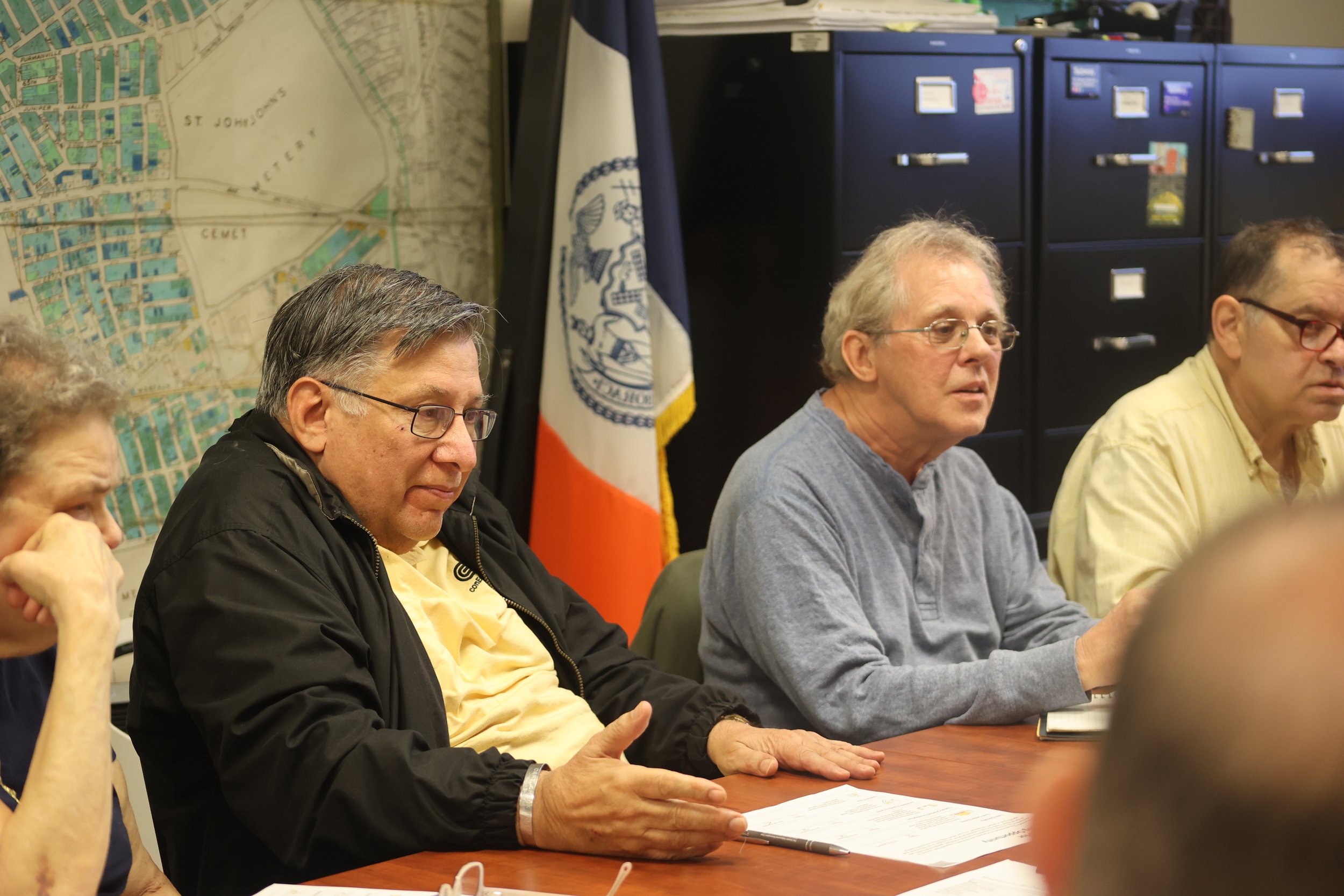City’s controversial housing plan begins review in Queens
/Members of Queens Community Board 5 heard the proposal for the City of Yes for Housing Opportunity, a citywide plan intended to change zoning in the five boroughs. Eagle photo by Ryan Schwach
By Ryan Schwach
The Adams administration officially began rolling out its controversial plan to rezone a large swath of the city, known as the City of Yes for Housing Opportunity, last week.
It began in Queens, where the Department of City Planning began its public review process for the proposal that is intended to bring “a little more housing to every neighborhood.”
The Land Use Subcommittee of Queens’ Community Board 5, which represents the heavily residential neighborhoods of Ridgewood, Glendale, Middle Village, Maspeth, Fresh Pond and Liberty Park, was among the first to get the city’s pitch on the plan, which has been in the works for the better part of Mayor Eric Adams’ two years in office.
The meeting, held in the small Myrtle Avenue office of Community Board 5, saw community board members pepper city officials with questions about the details of the plan. At times, board members interrupted DCP’s presentation and instead sought answers from a Queens urban planning consultant who has already positioned himself as a major opponent to the City of Yes proposal.
City of Yes for Housing Opportunity, the third portion of the city’s rezoning plan, is intended to overhaul the city’s pre-existing zoning laws, and allow for more housing to be built in every neighborhood. The plan intends to serve as a counter to how housing is currently built: in large numbers in specific neighborhoods, like Long Island City or Flushing.
The City of Yes Housing Opportunity plan includes provisions to allow for the building of apartments above commercial spaces, the end of parking mandates and other proposals.
“'City of Yes for Housing Opportunity' proposal – the most ambitious pro-housing proposal in New York City's history,” Mayor Eric Adams said at a kick-off for the proposal’s public review process last week.
“To address this housing crisis, we need to think bigger and act faster, and that's what our plan does,” he added. “We are calling our city councilmembers to listen to New Yorkers in need of more affordable housing and say 'yes' to the 'City of Yes for Housing Opportunity.'"
Before it can be implemented, City of Yes needs to go through the normal city review process, first passing through the beginning form of self governance the state has to offer – local community boards, whose opinions on the plan are taken in an advisory capacity.
However, if the first phase of the platform is any indication, the mayor won’t be getting a city’s worth of yeses ahead of the project's implementation.
While supported by many housing advocates, City of Yes has received heavy opposition from residential communities in the outer boroughs, who worry the increase in housing will negatively change the fabric of their neighborhoods.
The first phase of the platform – City of Yes for Economic Opportunities – was approved by less than half of the city’s 59 community boards.
Monday’s meeting, where the eight members of the Land Use Committee, including committee Chair Walter Sanchez and District Manager Gary Giordano, heard out the proposal from two DCP employees, Derek Jasmin and Matthew Mbamelu, could be a taste of what is to come for the housing portion of the plan.
Also present was Paul Graziano, a career urban planner and perennial City Council candidate. Graziano, who lives far outside of CB5, has positioned himself as a premier opponent to City of Yes, and has been retained by the Queens Civic Congress and other organizations to do analysis on the massive zoning proposal.
Graziano has spent the last several months on a barnstorming tour around community boards, arguing that City of Yes will essentially destroy neighborhoods in Queens.
In a phone conversation with the Eagle on Thursday, Graziano likened City of Yes to a nuclear bomb going off, and called it “apocalyptic.”
At the meeting itself, DCP’s Jasmin and Mbamelu, did their best to try and dispel that notion, and garner support from the Western Queens board members.
“City of Yes for Housing Opportunity is a citywide plan that will encourage incremental housing growth over a wide geography,” Jasmin said as part of the presentation.
“Our housing demand is greater than our housing supply,” he said, highlighting a 1.4 percent housing vacancy rate, which is 0.88 percent in Queens.
Community Board 5 members were already skeptical of the City of Yes for Housing Opportunity plan, and made their thoughts known to City Planning employees last week during a committee meeting. Eagle photo by Ryan Schwach
DCP also pointed to the Big Apple’s growing population. Graziano however was quick to point out the dip in population following the pandemic, but statistics show that rate has steadily rebounded since.
However, it showed members’ of the board's seemingly pre-existing distrust of the DCP employees, and trust in Graziano, who they have retained in other capacities.
“Paul Graziano is shaking his head, what’s the answer?” board member Paul Kerzner asked Graziano at one point during the meeting.
Committee chair and newspaper publisher Sanchez tried to reign the meeting back into listening to the proposal, at that point.
Questions from members of the board continued, specifically on the “transit-oriented development” piece of the proposal – which will allow more three-to-five story apartment buildings on wide streets and corners within half a mile of the subway. They also had a number of questions about an accessory dwelling unit proposal, which would allow for more backyard cottages, garage conversions and basement apartments, which city officials say will allow homeowners to earn rental income and while also providing more housing.
Board members said that they were worried that ADUs would be built too tiny for comfortable living, despite DCP’s insistence that other regulations would stop units from being too small.
Another major sticking point for the board was the aspect of City of Yes that would eliminate parking mandates for new buildings, a proposal which will more than likely be protested by Queens neighborhoods without a lot of transit access.
The point of eliminating the mandate would allow the space where parking spots would be to be used for more apartments. However, Graziano questioned why a developer couldn’t just not build more and pocket the extra cash made from not building the parking.
“When you have more supply, and it somewhat matches the demand, naturally, the price is lower,” said Mbamelu, arguing that building more units will be financially beneficial to developers.
After the full presentation was given, board members, particularly Sanchez, implored DCP to take their thoughts into consideration.
“More discussion, as opposed to everybody saying, ‘No,’” he said.
Ultimately, the committee decided not to give a recommendation at the meeting, and will bring their thoughts to the whole board.
Throughout May, other Queens community board members will hear the proposal before giving their recommendation.
Regardless, the plan is scheduled to go to a City Planning vote in September.





